check engine DODGE STRATUS COUPE 2004 2.G Owner's Manual
[x] Cancel search | Manufacturer: DODGE, Model Year: 2004, Model line: STRATUS COUPE, Model: DODGE STRATUS COUPE 2004 2.GPages: 388, PDF Size: 2.28 MB
Page 282 of 388
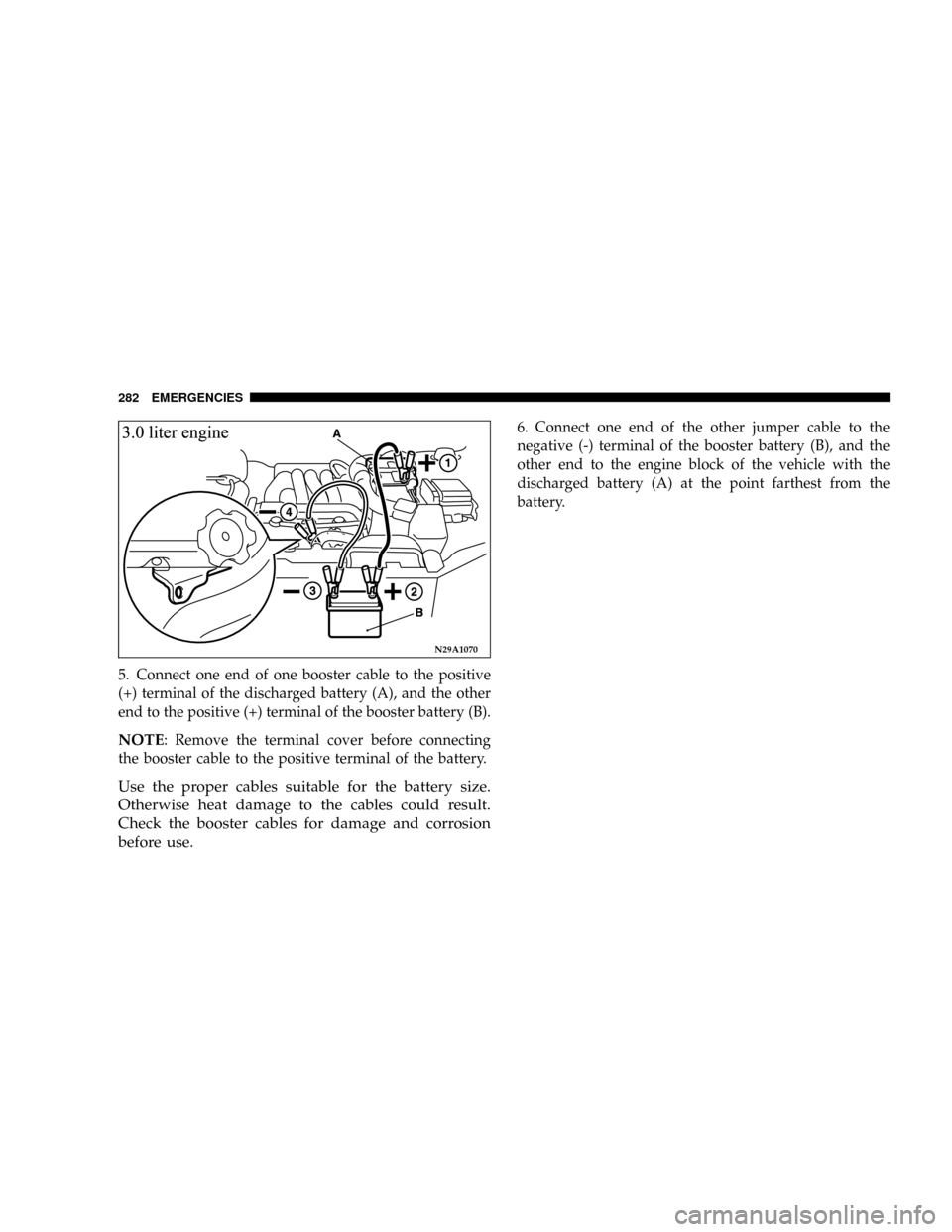
5. Connect one end of one booster cable to the positive
(+) terminal of the discharged battery (A), and the other
end to the positive (+) terminal of the booster battery (B).
NOTE: Remove the terminal cover before connecting
the booster cable to the positive terminal of the battery.
Use the proper cables suitable for the battery size.
Otherwise heat damage to the cables could result.
Check the booster cables for damage and corrosion
before use.
6. Connect one end of the other jumper cable to the
negative (-) terminal of the booster battery (B), and the
other end to the engine block of the vehicle with the
discharged battery (A) at the point farthest from the
battery.
N29A1070
282 EMERGENCIES
Page 309 of 388
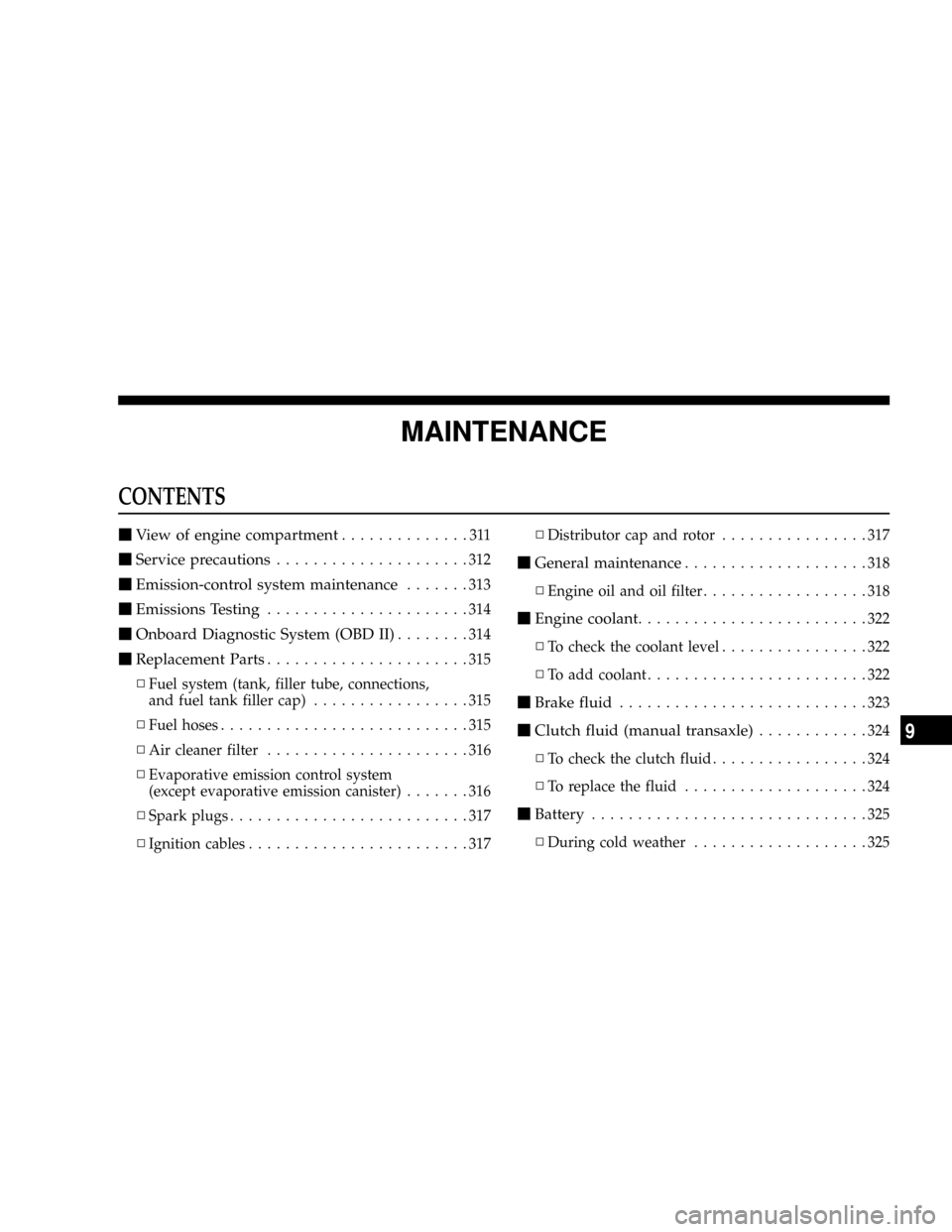
MAINTENANCE
CONTENTS
mView of engine compartment..............311
mService precautions.....................312
mEmission-control system maintenance.......313
mEmissions Testing......................314
mOnboard Diagnostic System (OBD II)........314
mReplacement Parts......................315
NFuel system (tank, filler tube, connections,
and fuel tank filler cap).................315
NFuel hoses...........................315
NAir cleaner filter......................316
NEvaporative emission control system
(except evaporative emission canister).......316
NSpark plugs..........................317
NIgnition cables........................317NDistributor cap and rotor................317
mGeneral maintenance....................318
NEngine oil and oil filter..................318
mEngine coolant.........................322
NTo check the coolant level................322
NTo add coolant........................322
mBrake fluid...........................323
mClutch fluid (manual transaxle)............324
NTo check the clutch fluid.................324
NTo replace the fluid....................324
mBattery..............................325
NDuring cold weather...................325
9
Page 312 of 388
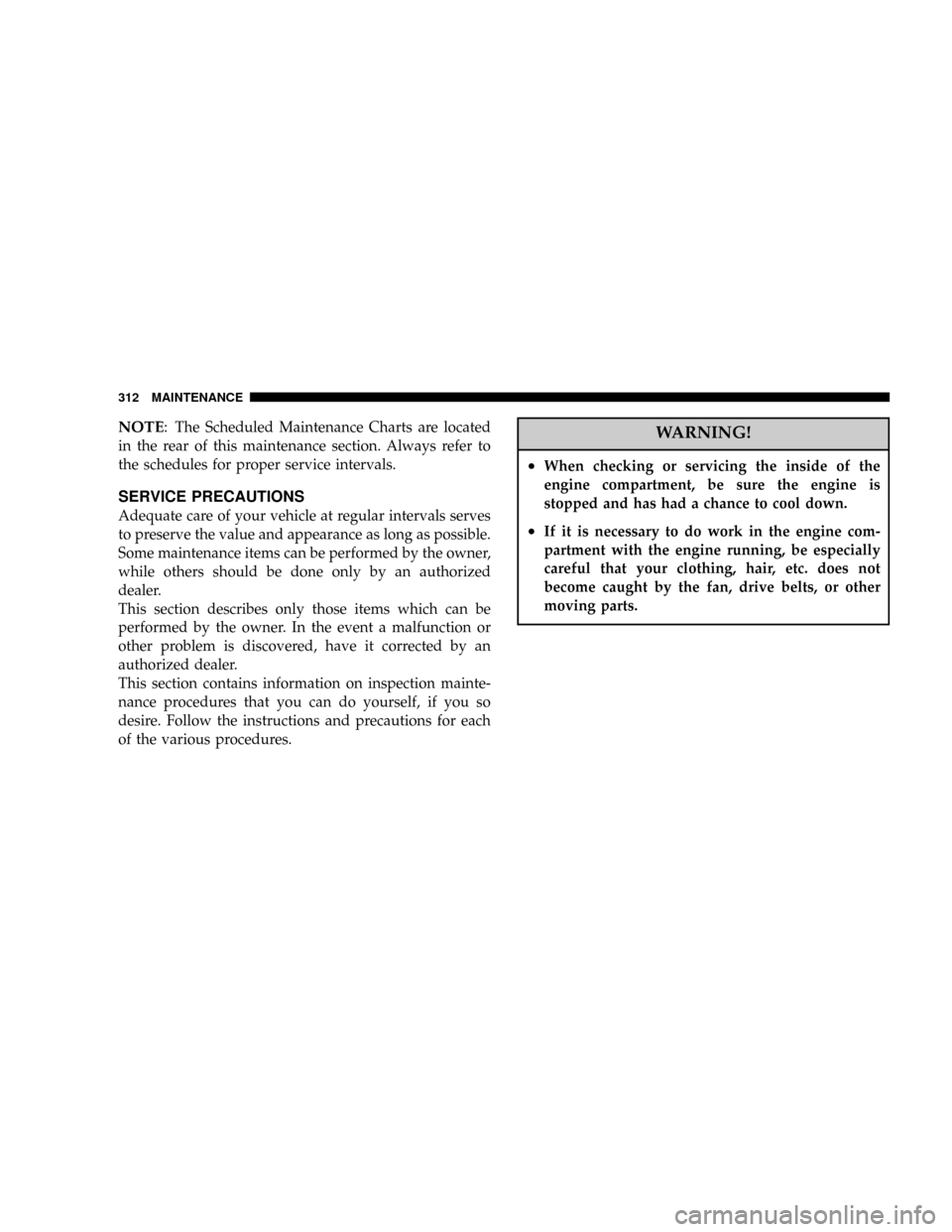
NOTE: The Scheduled Maintenance Charts are located
in the rear of this maintenance section. Always refer to
the schedules for proper service intervals.
SERVICE PRECAUTIONS
Adequate care of your vehicle at regular intervals serves
to preserve the value and appearance as long as possible.
Some maintenance items can be performed by the owner,
while others should be done only by an authorized
dealer.
This section describes only those items which can be
performed by the owner. In the event a malfunction or
other problem is discovered, have it corrected by an
authorized dealer.
This section contains information on inspection mainte-
nance procedures that you can do yourself, if you so
desire. Follow the instructions and precautions for each
of the various procedures.
WARNING!
²When checking or servicing the inside of the
engine compartment, be sure the engine is
stopped and has had a chance to cool down.
²If it is necessary to do work in the engine com-
partment with the engine running, be especially
careful that your clothing, hair, etc. does not
become caught by the fan, drive belts, or other
moving parts.
312 MAINTENANCE
Page 314 of 388
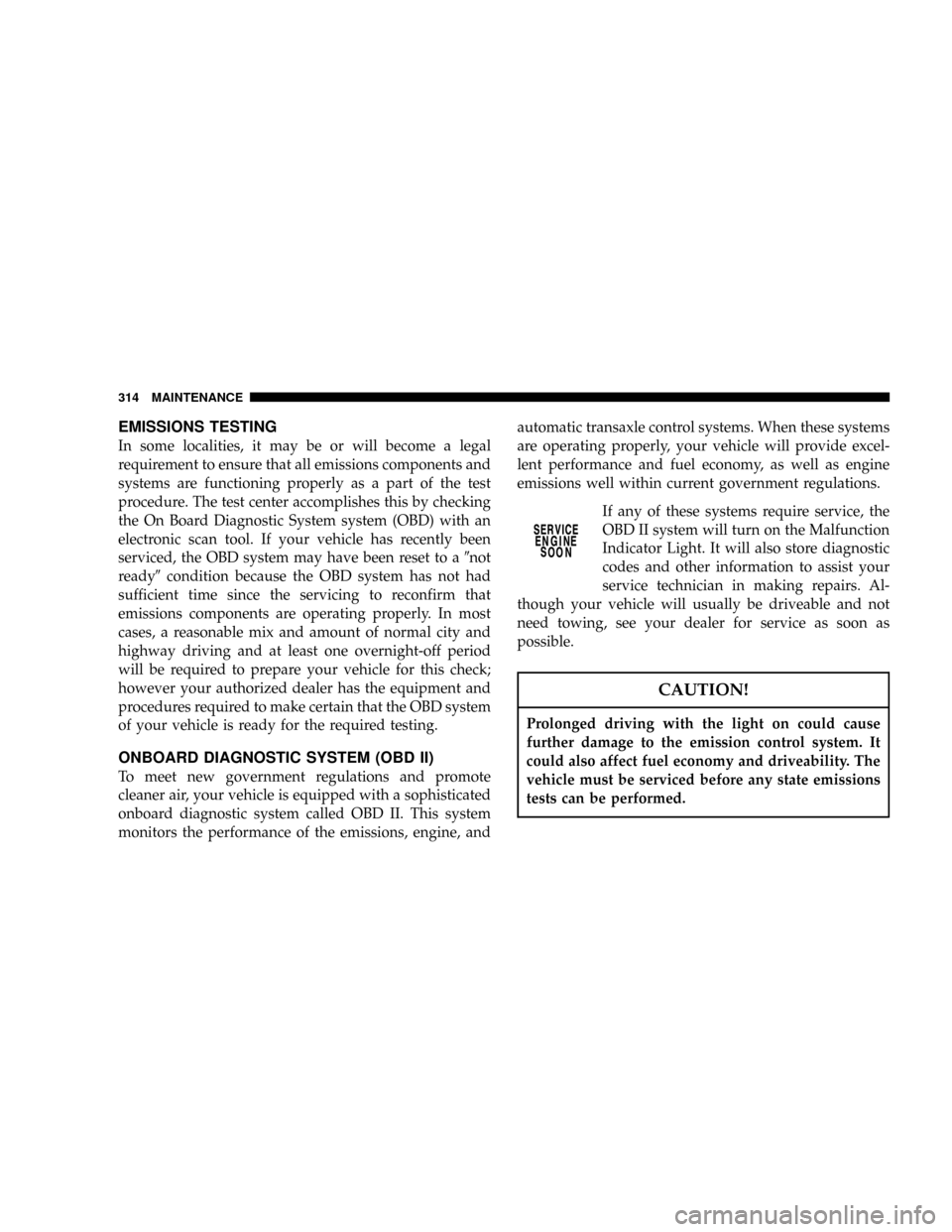
EMISSIONS TESTING
In some localities, it may be or will become a legal
requirement to ensure that all emissions components and
systems are functioning properly as a part of the test
procedure. The test center accomplishes this by checking
the On Board Diagnostic System system (OBD) with an
electronic scan tool. If your vehicle has recently been
serviced, the OBD system may have been reset to a9not
ready9condition because the OBD system has not had
sufficient time since the servicing to reconfirm that
emissions components are operating properly. In most
cases, a reasonable mix and amount of normal city and
highway driving and at least one overnight-off period
will be required to prepare your vehicle for this check;
however your authorized dealer has the equipment and
procedures required to make certain that the OBD system
of your vehicle is ready for the required testing.
ONBOARD DIAGNOSTIC SYSTEM (OBD II)
To meet new government regulations and promote
cleaner air, your vehicle is equipped with a sophisticated
onboard diagnostic system called OBD II. This system
monitors the performance of the emissions, engine, andautomatic transaxle control systems. When these systems
are operating properly, your vehicle will provide excel-
lent performance and fuel economy, as well as engine
emissions well within current government regulations.
If any of these systems require service, the
OBD II system will turn on the Malfunction
Indicator Light. It will also store diagnostic
codes and other information to assist your
service technician in making repairs. Al-
though your vehicle will usually be driveable and not
need towing, see your dealer for service as soon as
possible.
CAUTION!
Prolonged driving with the light on could cause
further damage to the emission control system. It
could also affect fuel economy and driveability. The
vehicle must be serviced before any state emissions
tests can be performed.
314 MAINTENANCE
Page 316 of 388
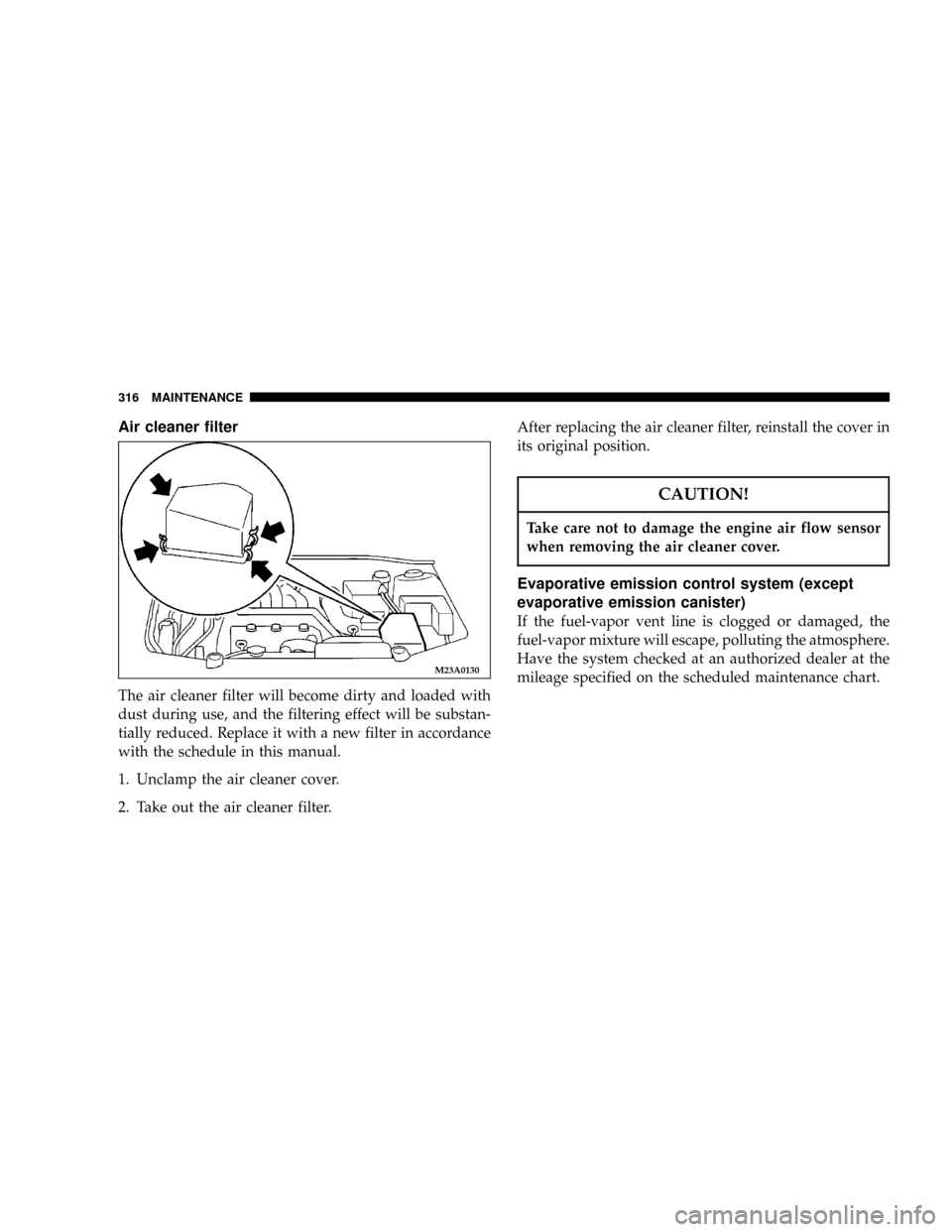
Air cleaner filter
The air cleaner filter will become dirty and loaded with
dust during use, and the filtering effect will be substan-
tially reduced. Replace it with a new filter in accordance
with the schedule in this manual.
1. Unclamp the air cleaner cover.
2. Take out the air cleaner filter.After replacing the air cleaner filter, reinstall the cover in
its original position.
CAUTION!
Take care not to damage the engine air flow sensor
when removing the air cleaner cover.
Evaporative emission control system (except
evaporative emission canister)
If the fuel-vapor vent line is clogged or damaged, the
fuel-vapor mixture will escape, polluting the atmosphere.
Have the system checked at an authorized dealer at the
mileage specified on the scheduled maintenance chart.
M23A0130
316 MAINTENANCE
Page 317 of 388
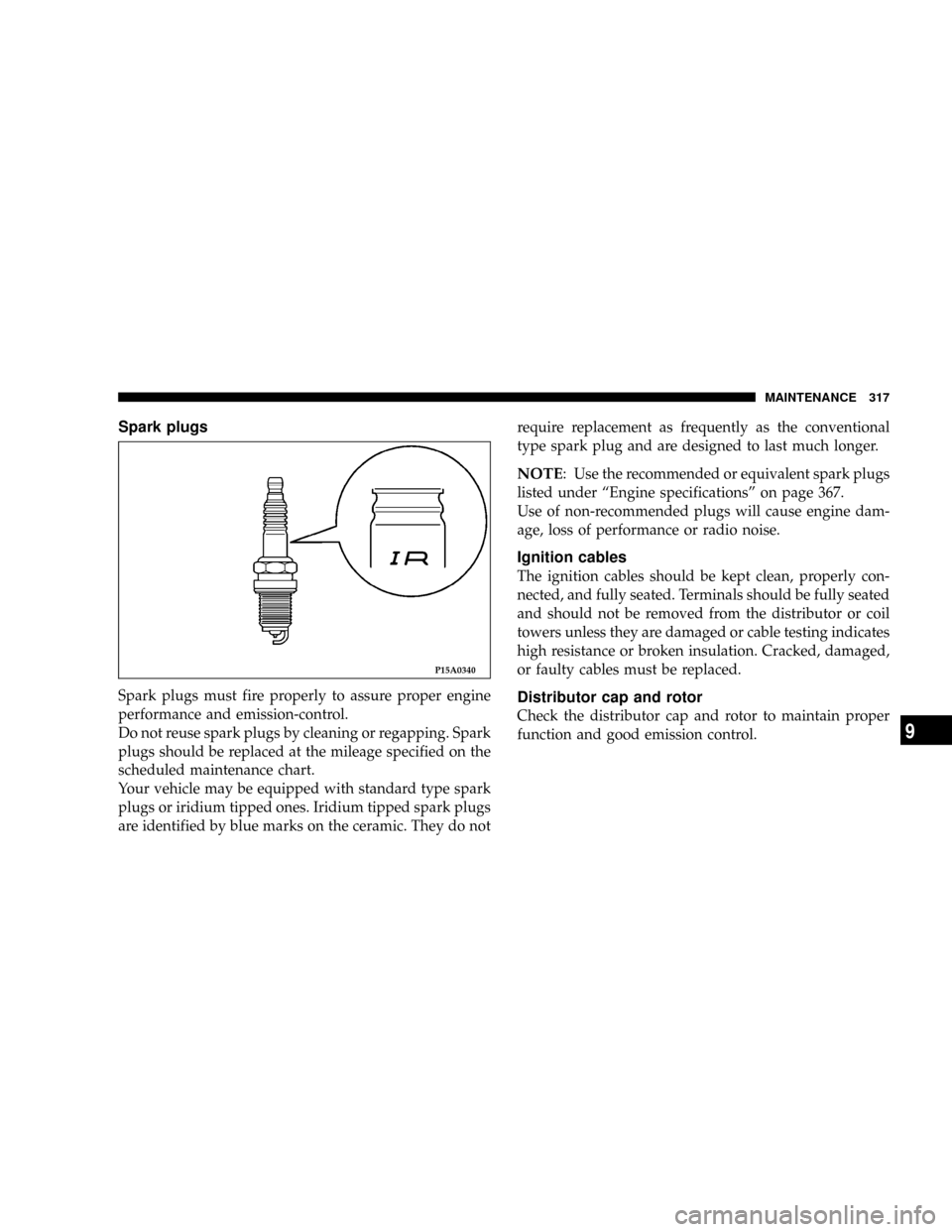
Spark plugs
Spark plugs must fire properly to assure proper engine
performance and emission-control.
Do not reuse spark plugs by cleaning or regapping. Spark
plugs should be replaced at the mileage specified on the
scheduled maintenance chart.
Your vehicle may be equipped with standard type spark
plugs or iridium tipped ones. Iridium tipped spark plugs
are identified by blue marks on the ceramic. They do notrequire replacement as frequently as the conventional
type spark plug and are designed to last much longer.
NOTE: Use the recommended or equivalent spark plugs
listed under ªEngine specificationsº on page 367.
Use of non-recommended plugs will cause engine dam-
age, loss of performance or radio noise.
Ignition cables
The ignition cables should be kept clean, properly con-
nected, and fully seated. Terminals should be fully seated
and should not be removed from the distributor or coil
towers unless they are damaged or cable testing indicates
high resistance or broken insulation. Cracked, damaged,
or faulty cables must be replaced.
Distributor cap and rotor
Check the distributor cap and rotor to maintain proper
function and good emission control.
P15A0340
MAINTENANCE 317
9
Page 319 of 388
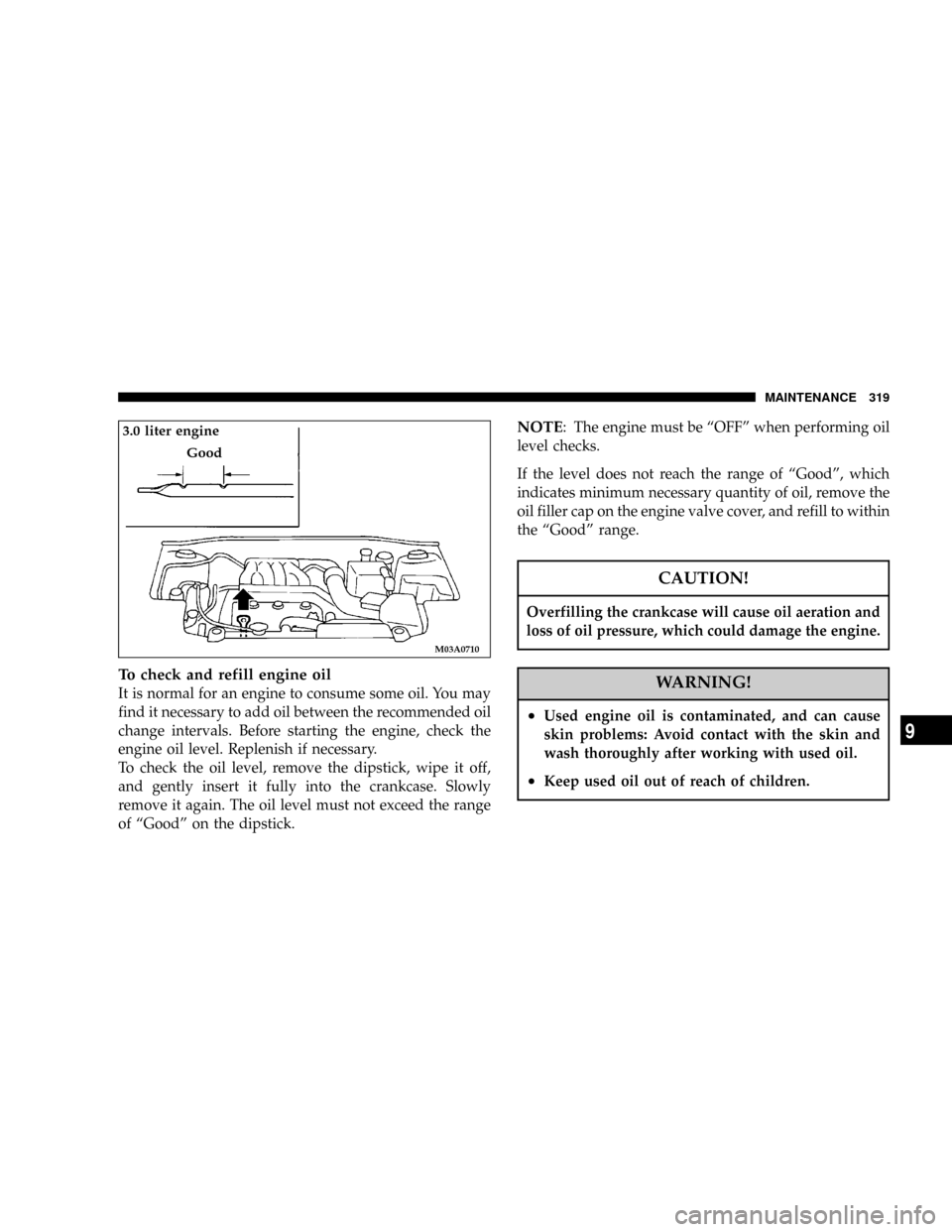
To check and refill engine oil
It is normal for an engine to consume some oil. You may
find it necessary to add oil between the recommended oil
change intervals. Before starting the engine, check the
engine oil level. Replenish if necessary.
To check the oil level, remove the dipstick, wipe it off,
and gently insert it fully into the crankcase. Slowly
remove it again. The oil level must not exceed the range
of ªGoodº on the dipstick.
NOTE: The engine must be ªOFFº when performing oil
level checks.
If the level does not reach the range of ªGoodº, which
indicates minimum necessary quantity of oil, remove the
oil filler cap on the engine valve cover, and refill to within
the ªGoodº range.
CAUTION!
Overfilling the crankcase will cause oil aeration and
loss of oil pressure, which could damage the engine.
WARNING!
²Used engine oil is contaminated, and can cause
skin problems: Avoid contact with the skin and
wash thoroughly after working with used oil.
²Keep used oil out of reach of children.
M03A0710
3.0 liter engine
Good
MAINTENANCE 319
9
Page 322 of 388

ENGINE COOLANT
To check the coolant level
The coolant reserve system provides a quick visual
method for determining the coolant level. When the
engine is cold, the level of the coolant in the reserve tank
should be between the FULL and LOW marks. The
radiator normally remains completely full so there is no
need to remove the radiator cap except for checking the
coolant freeze point or replacing the antifreeze coolant.
To add coolant
Use DaimlerChrysler Genuine Coolant or an equivalent.
Genuine Coolant provides excellent protection against
corrosion and rust formation of all metals, including
aluminum, and prevents clogs in the radiator, heater,
cylinder head, engine block, etc.
If frequent coolant additions are required, or if the level
in the reserve tank does not drop when the engine cools,
the system should be pressure-tested for leaks. Take your
vehicle to an authorized dealer for inspection of the
cooling system.
CAUTION!
²Do not use alcohol or methanol anti-freeze or any
engine coolants mixed with alcohol or methanol
anti-freeze. The use of an improper anti-freeze can
cause corrosion of aluminum components.
²When additional coolant is needed to maintain
the proper level, a minimum of 50% concentration
of ethylene-glycol antifreeze in water should be
added to the reserve tank. Do not overfill. A
higher concentration (not to exceed 60%) should
be used if a lower freezing point is required. The
concentration level can be checked using instru-
ments available at automotive supply stores, or
can be done by your authorized dealer or service
station. Use only high quality ethylene-glycol
antifreeze coolant formulated to prevent corrosion
of all cooling system metals.
²Do not top off with water only. Water by itself
reduces the rust-protective and anti-freeze quali-
ties of the coolant and has a lower boiling point. It
can also cause damage to the cooling system if it
should freeze. Do not use tap water, as it may
cause corrosion and rust formation.
322 MAINTENANCE
Page 323 of 388

Radiator cap
The radiator cap must be fully tightened to prevent loss
of coolant and engine damage.
WARNING!
Make sure that the engine is thoroughly cooled
down before removing the radiator cap, otherwise
hot steam or boiling coolant may gush from the filler
port and scald you.
Points to remember
1. Do not overfill the reserve tank.
2. A special radiator cap is used to ensure sealing and to
allow the coolant to return from the reserve tank to the
radiator when the engine cools. If cap replacement is
necessary, use the proper cap.
3. Check the coolant freeze point in the radiator using
proper instruments, when it is safe to do so. If antifreeze
is added, the contents of the reserve tank must be
protected against freezing.
4. Keep the front of the radiator clean. If your vehicle is
equipped with air conditioning, keep the front of the
condenser clean.5. If the temperature of the engine coolant does not rise
normally after engine warm-up, take the vehicle to an
authorized dealer to have the thermostat checked, and
replaced if necessary.
BRAKE FLUID
Recommended brake fluid conforming to DOT 3 or DOT 4
should be used. The reservoir cap must be fully tightened
to avoid contamination from foreign matter or moisture.
CAUTION!
²Do not allow petroleum-based fluid to contact,
mix with, or otherwise contaminate the brake
fluid. Seal damage will result.
²Take care in handling brake fluid as it may cause
damage to painted surfaces.
²Use only the specified brake fluid. Also, the
additives in different brands may result in a
chemical reaction when mixed together, so avoid
mixing different brands if possible.
²Keep the reservoir tank cap closed to prevent the
brake fluid from evaporating or absorbing moisture.
MAINTENANCE 323
9
Page 325 of 388

BATTERY
The condition of the battery is very important for quick
starting and proper functioning of the vehicle's electrical
system. Check the battery at regular intervals.
To determine the battery charge, check the battery test
indicator on top of the battery.
If the test indicator is a blue/green color when viewed
from above, the battery is OK. A black colored indicatormeans the battery is low on charge and may require
charging. Have it checked at an authorized dealer.
During cold weather
The capacity of the battery is reduced at low tempera-
tures. This is the result of its chemical and physical
properties and this is why a very cold battery, particu-
larly one that is not fully charged, will only deliver a
fraction of the starter current that is normally available.
It is recommended that you have the battery checked by
an authorized dealer before the start of cold weather and,
if necessary, have it charged or replaced. This not only
ensures reliable starting, but prolongs battery life.
Disconnection and connection
To disconnect the battery cable, stop the engine, discon-
nect the negative terminal first, then the positive termi-
nal. To reconnect the battery, first connect the positive
terminal and then the negative terminal, before starting
the vehicle.
M07B0080
Test indicator
MAINTENANCE 325
9